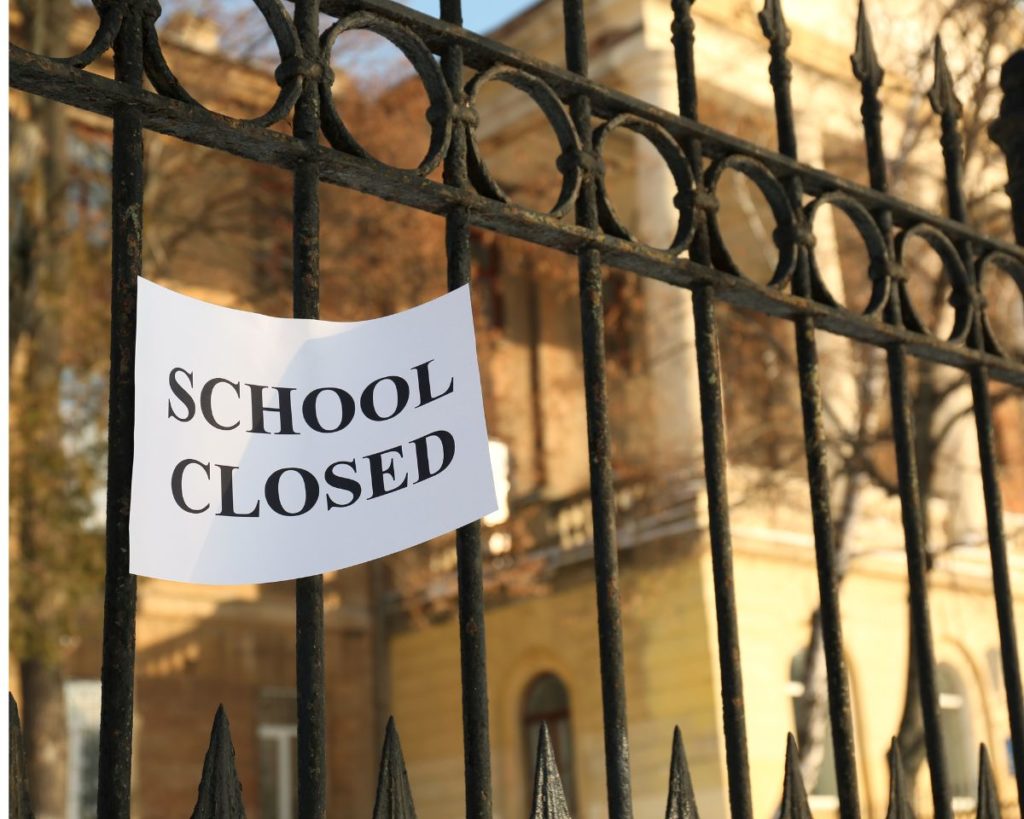Editor’s note: The following piece first appeared on the Center on Reinventing Public Education (CRPE) website. CRPE is a research organization at Arizona State University’s Mary Lou Fulton Teachers College where transformative ideas are rigorously examined and tested, and research informs action. This article was written by Paul Hill and Parker Baxter. Hill was the founder of CRPE and is an Emeritus Professor at the University of Washington Bothell. Baxter is the director of the Center for Education Policy Analysis, University of Colorado Denver School of Public Affairs.
It seems especially timely in the wake of the marathon Nov. 3 Denver school board work session, where board members and district leadership grappled with the possibility of closing several schools at the end of the current school year because of declining enrollment. Based on the discussions during that meeting, the district does not appear to have followed the suggestions outlined in this article. Boardhawk received permission from CRPE to republish the piece here.
Enrollment declines nearing 10% in Los Angeles, New York, Chicago, and other metro area school districts this fall have revived the possibility of closing and consolidating schools. While some urban communities have a long history of doing so, in places like the Atlanta metro area and California’s San Fernando Valley, it was previously unimaginable.
The topic is hot again 10 years after it made headlines in cities that were closing poor-performing schools considered so troubled that no student should be required to attend them. Now, the issue is simpler: money. Paying for administrative staff and building upkeep in under-enrolled schools costs a great deal of money that could otherwise go into classrooms.
We at the Center on Reinventing Public Education at Arizona State University and Center for Education Policy Analysis at the University of Colorado Denver have recently watched the pressures for school closures in Aurora, CO. Its school district of 38,000 students east of Denver foresaw changes in enrollment and engaged parents and community members in planning for future building needs.
Enrollment was growing in one part of Aurora, which created the opportunity to create new schools there, yet declining overall and especially in another part of the city, meaning that some schools might need to be closed. Starting in 2019, hundreds of parents participated in design teams to plan new magnet schools, upgrade facilities, and improve educational outcomes for the district’s diverse student population.
District leaders focused the process on designing new schools and programs, but were blindsided by parent resistance to the related closing of under-enrolled schools in shrinking neighborhoods. As we reported previously, the district pursued thoughtful, multiyear outreach to families and school communities, but the people directly impacted by potential closures didn’t feel heard. Though families knew some schools needed to close, the parents of the schools selected for closure ultimately launched a firestorm of protests. The school board first voted down the closure proposal. District administrators then used data to show how schools were selected for closure and explained again how the closures would enable district-wide improvements. This evidence eventually won the day, and the board voted to close the schools, but resentments remained.
Aurora is now working to re-engage and reassure the affected parents—and help students make a successful transition to their new schools. It and other districts can use the lessons learned and documented in the past about how to close schools while limiting pain.
School closing challenges
School closing is a classic problem of termination. Many of the possible benefits, such as reducing the district’s budget deficit, benefit everyone just a little bit and often in the long term. The harms, on the other hand, are felt intensely by a few and appear immediately. There is rarely a constituency to close a school, but always one to oppose it.
School closings reveal serious conflicts of responsibility and interest. The core conflict is between the school district’s responsibility to do everything possible on behalf of students citywide, and some teachers’, parents’, and neighbors’ fears that closing their school will do more harm than good. District leaders must expect resistance and make sure the likely benefits are substantial—not only to the city overall, but also to the students in the school to be closed. And they must be able to communicate these benefits in a compelling way.
School closings can also arouse parties that are normally quiet about education issues. For example, elected officials serving small geographic areas (members of the city council, school board, or state legislature) might object to closing a school serving their constituency, or replacing a zoned-attendance neighborhood school with a school of choice. They have reason to fear that some of their constituents will send their children elsewhere and therefore lose connection with the community and its leaders.
Families and others concerned about a possible school closure might change their minds under the right circumstances. But district leaders need to address parents’ understandable fears: first, that closure decisions are made arbitrarily and in a way that ignores their school’s good qualities; second, that closing the school will take away an asset that unites and energizes their neighborhood; and third, that children will be switched to another school that has serious problems and would be a bad fit. These fears are serious, and not all families can be reassured.
Lessons from a decade ago
Districts can then take several steps to mitigate the harm of school closings. The following summarizes key recommendations from our 2012 report on this issue:
- Establish clear criteria, measures, and timelines before the closure process starts.
- Make sure schools that are candidates for closure are not deprived of staff and money before the closure decision is made.
- Publish in advance the data and criteria on which closure decisions will be made and provide comparable evidence for all schools.
- Give advance notice to communities whose school will be considered for closure, using the published criteria.
- Describe in advance how the closed building(s) will be used and the new school placement options for students, teachers, administrators, and staff.
- Make school closure early enough, preferably a whole academic year before closure happens, that parents who want to opt out of a school have time to find good alternatives.
- Publish plans for placing children in other schools and help parents assess and choose from those options.
- Assign children from schools that are candidates for closure as high-priority in new schools through the district’s transfer or school choice system and ensure that enough seats are available to serve them.
- Fully inform and prepare the school board to deal with the inevitable complaints and resistance.
- Establish a defined but short amount of time (weeks not months) between announcing a slate of schools for closure and the final school board vote on the plan.
Our 2012 report on school closure policies in four large cities explains how New York City, under former mayor Mike Bloomberg, protected children in schools slated for closure. First, he allowed students about to graduate to stay in the school until they graduated, even as the rest of the school closed. Second, he gave parents choices among new schools and provided information and counseling to help them make a choice. Third, he gave children from the closed schools preferences in admissions lotteries for seats in new schools.
New York City’s process forced district officials to do more work than simply announcing a school closing and letting families fend for themselves. But those actions did not satisfy the teacher’s union nor some parents and neighborhood leaders. And when former Mayor Bill DeBlasio took office, he pledged not to close any schools during his term. But the Bloomberg era school closing policy was objectively beneficial for the affected kids. Even those who chose to stay in the old school did better than expected thanks to smaller classes, limited electives, and more focused teaching, one study showed.
In contrast, we documented the manner in which Chicago closed schools abruptly in the mid-2000s and left it to parents to find new options. Many families complained that the only new schools with open seats were deeply troubled and that, to gain access, children often had to cross through dangerous gang turf. Some parents were not sure their children could find places in schools as welcoming as those that were being closed, and the lack of transparency led to charges that closure decisions were driven by politics and racial agendas, not clear criteria.
Also in our 2012 report, we feature a more positive example from Oakland and Alameda, CA. The triage model for school closings in those cities, developed by Kirsten Vital, a former Alameda superintendent, was evidence-driven and transparent. The process first called for publishing criteria for determining a school’s eligibility for closure and sharing objective data for all schools. Then, schools were classified into three tiers (not candidates for closure, schools on notice with time to improve, and schools to be closed). This process allayed parents’ suspicions that closure decisions were made capriciously or were biased against particular neighborhoods or racial groups.
Today, more inclusive processes are still underway in Oakland. The city is home to a new grassroots parents group that developed and successfully lobbied the school board to adopt an “opportunity ticket” that protects students in schools being closed by preserving seats for them in higher-performing schools.
Preparation is vital
These districts all highlight one of the central tensions in the closure process. School system leaders need to strike a balance between using simple, transparent criteria while providing enough leeway to consider subjective factors, such as school leadership quality or whether the low-performing school seems to be improving. These criteria also need to be spelled out in advance.
District leaders also can take steps to anticipate–and constructively address–the inevitable pushback that will come from concerned staff, families, and others. School boards should be trained to navigate the closure process. School closures are likely to be the most publicized and personally felt decisions that school board members make. Their training should prepare them for contentious public meetings and set them up to successfully interact with the concerned and often angry communities affected.
City and school district leaders need to think about the sources of opposition and support. Anticipating challenges can help city leaders mitigate avoidable harms, allay ungrounded fears, and otherwise reassure stakeholders that the decisions will benefit the community overall. Failure to recognize and consider the resistance to school closure decisions can lead to the defeat of otherwise necessary and beneficial policies.
Whether districts can adjust to declining enrollment by closing schools is a matter of public leadership. As district leaders in Aurora now know, good planning, communication, and engagement are necessary, but there will always be opposition.




